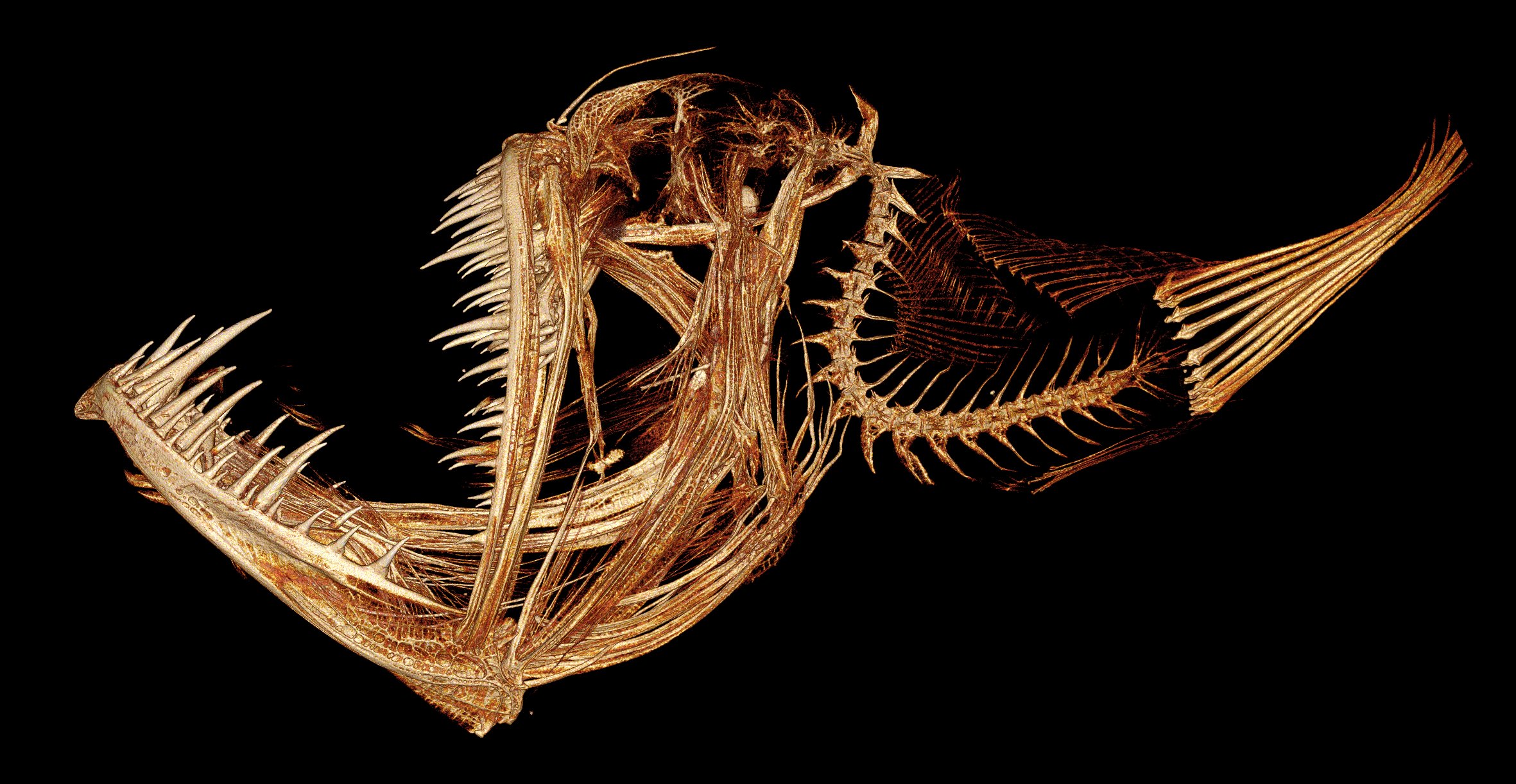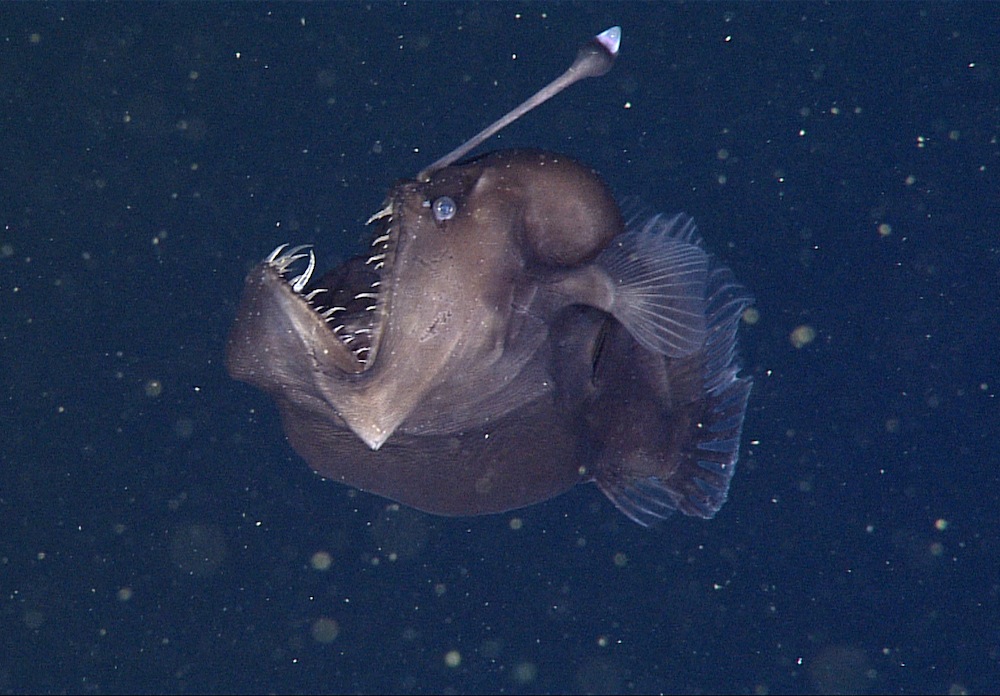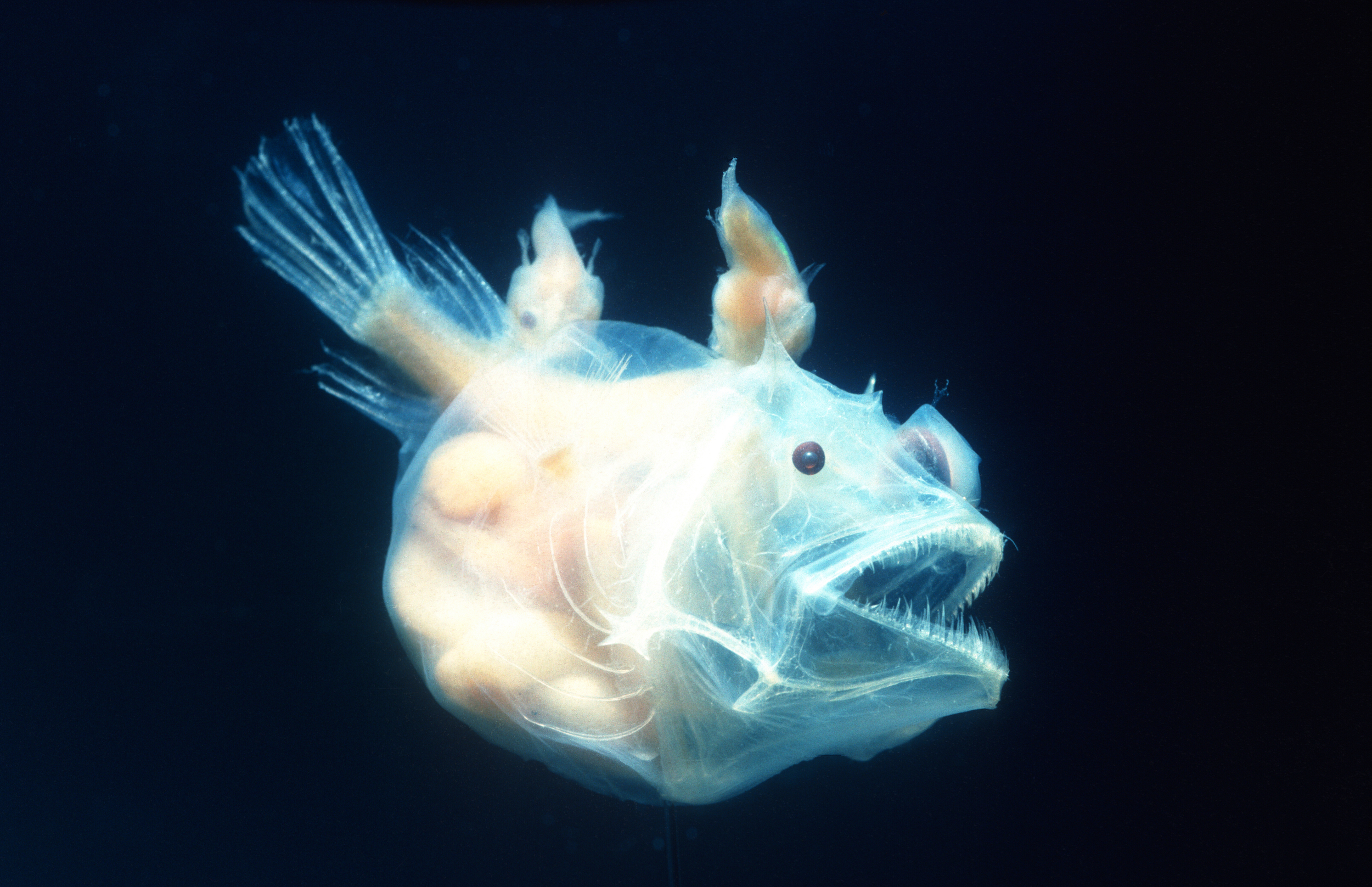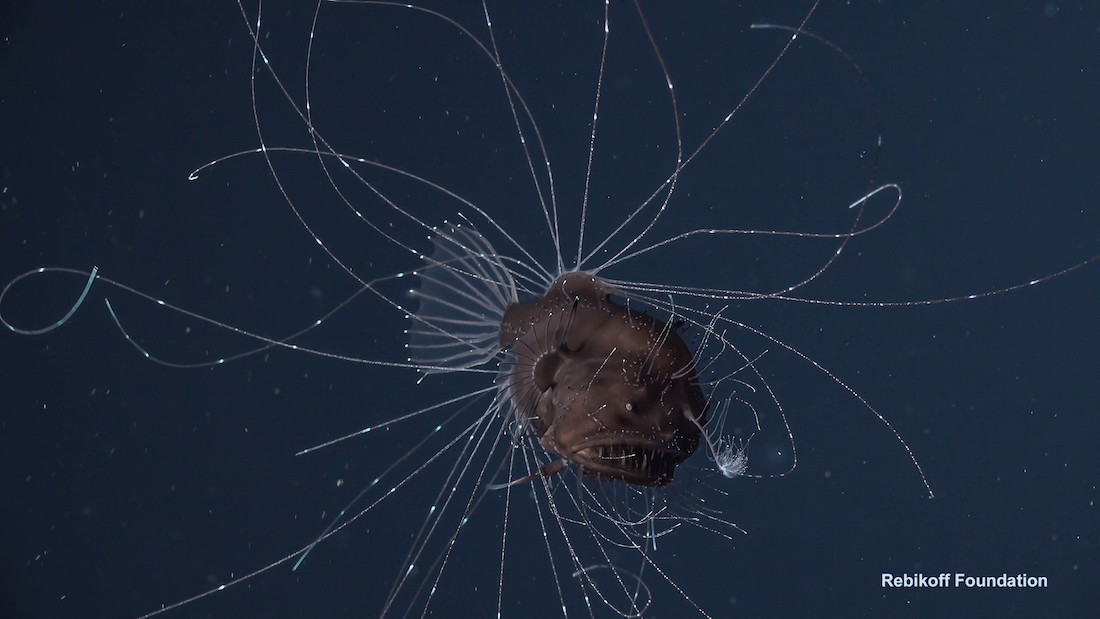Anglerfish: Biology, bioluminescence and lifecycle
Deep-sea anglerfish are some of the most bizarre animals of the ocean.

Anglerfish are one of the most frightening creatures to swim in the ocean. If its bucket-sized mouth bearing razor-sharp teeth, tiny frosted eyes and spiky fines weren’t scary enough, add its ability to lure its prey with glowing head lanterns and the anglerfish becomes the stuff of nightmares.
In 1833, an almost perfectly spherical fish washed ashore in Greenland and was taken to zoologist Johannes Christopher Hagemann Reinhardt in Copenhagen, Denmark. This fish – later known as the footballfish, Himantolophus groenlandicus, or the man-gobbler – was the first anglerfish known to science, wrote Ted Pietsch, a systematist and evolutionary biologist, in his book "Oceanic Anglerfishes" (University of California Press, 2009).
Today, there are about 170 known species in 12 families of deep-sea anglerfish, and a "huge diversity" within those families, Mackenzie Gerringer, a professor of biology at SUNY Geneseo in New York who specializes in deep-sea fish told Live Science.
Common names for anglerfish hint at some of the wild forms they can take – snaggletooth sea devil, wolf trap and pugnacious dreamer (also known as the tyrannical toad), to name just a few. They sport a fantastic range of shapes and textures; some are squat and round (Melanocetus johnsonii), while others are flat and huge-snouted (Thaumatichthys binghami) or covered in whiskery filaments (Caulophryne jordani). But while these fish are found all over the world, they are fairly elusive, solitary – par for the course for a fish that lives 1,000 to 16,400 feet (300 to 5,000 meters) below the surface. As a result, new species are still being discovered, each more strange than the last.
But no matter what it looks like, any deep-sea anglerfish is a small ocean-dwelling creature’s worst nightmare.
Luring in the unlucky
Anglerfish are named for the glowing lure they use to attract the fish and crustaceans they eat. These fearsome hunters lurk quietly in the depths of the ocean. They’re ambush predators, Gerringer said, floating and waiting in the dark until prey comes near. Then, they use their built-in fishing rod to lure in the unlucky animal, wiggling, hiding and revealing their lure to tempt potential prey until they are close enough to be sucked up.
This feeding strategy explains anglerfish’s bodies: Because they don’t actively hunt, they haven’t evolved to be fast swimmers, which is why many are blobby, non-hydrodynamic shapes. National Geographic even called anglerfish "quite possibly the ugliest animal on the planet" (though the blobfish would like a word).
Get the world’s most fascinating discoveries delivered straight to your inbox.

In the deep ocean, meals are few and far between. Pietsch wrote in Oceanic Anglerfishes that most anglerfish stomachs that have been examined are empty. So when an anglerfish does come across a meal, they make it last. Anglerfish mouths are often the biggest part of their bodies, and if a meal “can fit in the mouth, it can fit in the body,” Gerringer said. Many anglerfish can stretch their stomachs to double their original size.
"They’ll end up with a bubble belly," she told Live Science. "Sometimes they’re caught and they have whole fish in their stomachs. If you touch the stomachs, it’s quite squishy, for lack of a better term."
But don’t worry too much about these deep-sea horrors: They’re far too small to hurt a human, making their oversized teeth and misshapen bodies… kinda cute? While some anglerfish can grow up to three or four feet (0.9 to 1.2 m) long (like Ceratias holboelli), the average size of an adult is 6 inches (16 centimeters) long — a little smaller than a volleyball.
Glow up
Anglerfish lures glow in the deep ocean, at least half a mile (0.8 kilometers) below the sunlit surface, thanks to luminescent bacteria that take root in the fish’s lure. The lure, also called an "esca," has a pore on the end that is designed to host these bacteria, many of which can’t live anywhere else, and many of which are unique to that species of anglerfish.
But where do the glowing bacteria come from? Anglerfish are born deep in the ocean as tiny, transparent larvae and float alone to the surface to feed and develop into their adult forms. They don’t grow an esca until later in life, so they have nowhere to nurture their bacterial colonies from birth, Gerringer said. "It’s a big research question right now," she added.
Of the anglerfish esca bacteria that have been studied, none have been found living freely in seawater, Pietsch wrote in his book, meaning that it’s unlikely the fish pick their glowing buddies up from their environment.
Do they live on an anglerfish’s skin until the esca develops? Do they, as one study in the journal eLife suggested in 2019, come from adult anglerfish spewing bacteria into the water, to be immediately picked up by younger fish? "There’s a lot of open questions," Gerringer said.
The diverse anglerfish don’t stop at a simple glowing lure, though. Some species, such as Phyllorhinichthys balushkini, have elaborate light guides protruding from their bodies, like biological fiber optic cables. Others, like Cryptopsaras couesii, have glowing spots on their backs called caruncles. Some, like members of the Thaumatichthys genus, have lures on the roofs of their mouths.
Snapping the trap with anglerfish teeth

Once an anglerfish has lured in its prey, the fish has every incentive to keep it. According to Karly Cohen, a PhD candidate studying the biomechanics of fish teeth at the University of Washington, most animals sport teeth that are firmly attached to their jaws – with anglerfish as a notable exception. Some of their fang-like teeth are "depressable," or able to fold in under pressure. "It could be that the teeth are working similar to a spike guard in a parking garage," Cohen told Live Science. "It's easy for prey to go in the mouth, but hard for them to get out."
To understand anglerfish teeth, Cohen uses a technique called histology. She embeds teeth into resin blocks, and then slices that block microscopically thin. That way, she and her colleagues can stain and identify specific tissues (enamel, pulp and ligaments, for example) to determine how those teeth developed.
But a newer technique allows Cohen to get an even better look at one anglerfish’s jawful of fangs. Using a CT scan, Cohen virtually sliced the entire fish into sections that could then be reassembled digitally and viewed from any angle.
Unlike us, Cohen said, "fish put teeth everywhere," and often in places that are hard to spot while just looking at a specimen. With a 3D rendering of a tiny (but ferocious) fish like Melanocetus johnsonii, just 2 inches (5 cm) in length, Cohen and her colleagues can make better models of these elusive animals’ bite.
The worst sex on Earth

Many species of deep-sea anglerfish have one of the weirdest reproduction strategies on the planet. Males are parasites – and we don’t mean that metaphorically.
In many deep-sea anglerfish species, the males are often 10 times smaller than females, said Gerringer, and they have no function other than to reproduce. They use highly developed scent organs to track down females. When they find one, they bite into her: According to Cohen, some male anglerfish develop specialized hooked teeth in front of their mouth specifically for getting a grip. (Cohen is researching whether these teeth are true teeth or a kind of proto-tooth called odontodes.) Then, they release an enzyme that dissolves the skin of their mouth, fusing with the female’s body. The males become completely dependent on the female for sustenance; their circulatory systems merge so that they’re sharing the same blood, and essentially the males become a living pair of testicles.
"Since there’s a low probability to run into each other in the ocean, you want to be able to stick together when you find a mate. And they take this to the extreme," Gerringer said.
Females don’t stop collecting partners when they have one male fused to them: The record, Gerringer said, is 12 males to one female.
The fusing that takes place is similar to an organ transplantation, since the males essentially become a part of the female’s body. Research published in the journal Science in 2020 found out how anglerfish manage this feat: They lack genes to produce most of the molecules that would attack foreign tissue – plus they have few or no T-cells and antibodies. This lack of an immune system would likely kill a human, study co-author Dr. Thomas Boehm said in a press release describing the study, but it’s exactly what anglerfish need to carry out their weird sexual parasitism-based reproduction.
Changes in the deep ocean

Not many creatures in the ocean eat anglerfish (although some have been found in the stomachs of other deep-sea predators, such as the Antarctic toothfish, Dissostichus mawsoni), and since anglerfish make their home in deep water, they are not really targeted or accidentally caught by humans. So you might think that the anglerfish population is perfectly safe.
However, that’s not the case. "We think of deep ocean communities as being out of sight, out of mind, but they’re closely connected to the rest of the ocean ecosystem," Gerringer said. A recent opinion article published in the journal Proceedings of the National Academy of Sciences argued that deep-sea mining in search of increasingly scarce rare earth minerals could become a threat to the ocean. The emerging technology, as reported by Nature, could shoot sediments and mining waste from the seafloor up into the water column where it could remain in the mid-ocean. That habitat is home not just to anglerfish but tens of thousands of other species, according to a report in Science Daily. That muck could clog up gills, starve filter-feeders and change the way light – and the allure of an anglerfish’s esca – travels in the ocean.
Climate change is a threat too, Gerringer said, by increasing ocean stratification. This means that water isn’t mixing from the surface down into the deep ocean as much as it used to, so less oxygen is making its way down to the depths. Ultimately, though, anglerfish are still so mysterious that for many, "we just don’t know" how humans might affect them, Gerringer said – or even what their baselines are.
But technology is improving all the time. In 2014, the Monterey Bay Aquarium Research Institute captured the first ever video of a “black seadevil” anglerfish and then brought it to the surface for a closer look, expecting that the fish wouldn’t live long at sea level. But in 2018, National Geographic reported how scientists’ ability to safely bring live deepwater fish to the surface is evolving. Someday soon, thanks to developments like these and the continued exploration of the deep ocean, we may know more about these bizarre, mysterious creatures.
Additional resources
Explore the deep-sea anglerfish family on the Tree of Life. For more facts about the ocean’s “twilight zone” from the Woods Hole Oceanographic Institute.
Bibliography
- Theodore W. Pietsch, "Oceanic Anglerfishes: Extraordinary Diversity in the Deep Sea", University of California Press, 2009.
- Census of Mariner Life, "How Many Fish In The Sea? Census Of Marine Life Launches First Report", Science Daily, October 2003.
- Olive Heffernan, "Seabed mining is coming — bringing mineral riches and fears of epic extinctions", Nature, July 2019.
- Jefferey C. Drazen, "Midwater ecosystems must be considered when evaluating environmental risks of deep-sea mining", PNAS, July 2020.
- Jeremy Swann, "The immunogenetics of sexual parasitism", Science, July 2020.
- University of Washington, "Deep-sea anglerfishes have evolved a new type of immune system", July 2020.
- National Geographic, "Anglerfish", accessed April 2022.
Rachel is a writer and editor based in Washington, D.C., who covers a range of topics for Live Science, from animals and global warming to technology and human behavior. Rachel also contributes to National Geographic News, Smithsonian Magazine and Scientific American, and she is currently a senior editor at Next City, a national urban affairs magazine. She has an English degree with a journalism concentration from Adelphi University in New York.




